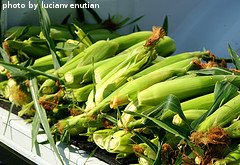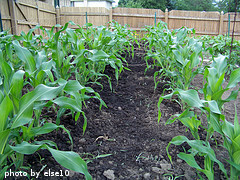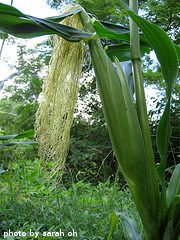How To Grow Sweet Corn
Ready to learn how to grow sweet corn? Growing sweet corn really only involves 3 easy steps - planting, watering and harvesting. Of course you'll probably need some fertilizer along the way, too, but we'll get to that.
Nothing says summer like freshly picked sweet corn. The key is to harvest it when the sugar content is at its peak. If you pick it too early, the corn won't be quite as sweet because the sugars won't have fully developed. If you wait too long, the sugars start converting into starches and the corn won't taste as sweet.
Sweet corn grows on tall plants, which can eventually provide a fair bit of shade in the garden. Because of this, think carefully about where you want to grow your corn and what plants will be next to it. You don't want the sweet corn providing too much shade over other plants that love as much sun as possible.
Here's some sweet corn seeds if you're interested...

There are many varieties of sweet corn. Most varieties grown by the backyard vegetable gardener are either white, yellow, or a combination of the two.
Most of the time, sweet corn is not appropriate for container gardening. You need a fair amount of garden space when growing corn. A minimum of 4 rows should be planted side by side for proper pollination. Because the rows should be set 3 feet apart, you'll need at least 50 square feet of garden space at a minimum. There are some new varieties of sweet corn that have been developed to grow specifically in containers, but we don't have any experience growing those.
Sweet corn is typically planted in the spring for harvest in the late summer. It thrives when daytime high temps are in the 70-85 degree F range and the seeds can be planted when the soil temps reach 60 degrees F. Sweet corn will certainly tolerate hot weather for several weeks as long as the soil stays moist. Most sweet corn varieties are ready for harvest in 70-85 days from germination.

Most sweet corn varieties grow 6-7 feet tall and are ready to harvest 75-95 days after planting. Each plant will produce 1-3 ears of corn, depending on the variety planted.
There are 4 main categories of sweet corn:
SE, or sugar enhanced hybrids, have the highest sugar content of any sweet corn varieties. They do not need to be isolated from other sweet corn categories when planted in the garden.
SH2, or super sweet hybrids, are very sweet and have a crisp texture. They must be planted separate from other corn varieties to prevent cross-pollination.
SU, or normal sugar hybrids, have the highest yields. However, they are not quite as sweet or crisp as the SE or SH2 varieties. The flavor and texture is very good. SU varieties are considered the standard of quality among sweet corn varieties. No isolation is needed when planted with other sweet corn varieties.
Heirloom sweet corn is known for its full flavor and substantial texture. Some heirloom varieties can be traced back more than 100 years. Heirloom sweet corn should be planted away from other corn varieties to prevent cross pollination.
Quick Overview of How To Grow Sweet Corn
Planting: When soil temps reach 60 degrees F, plant seeds 2 inches deep and 6 inches apart in rich well-tilled soil, thin to 1 foot apart
Fertilizing: Use balanced fertilizer and apply when plants are 12 inches tall
Watering: Needs 1.5 inches of rain per week, keep soil moist but not soggy
Harvesting: Ears are usually ready to be picked 3 weeks after silks first appear when silks are dry and brown,
Recipes: Can be boiled, steamed, roasted, smoked, sauteed, fried, grilled, dried and ground
Sweet corn is easy enough to grow that it is a great way to introduce kids to gardening. The plants will usually be taller than the kids, which automatically makes it unique and something of interest to little ones. Also, sweet corn is easy enough to pick without damaging the plant, which makes it perfect for small hands. Also, it's fun for kids to clean the husks and silk off the cobs - it's almost like unwrapping a present. And most kids like eating corn on the cob.
In our own garden, we like to grow a couple of different varieties of sweet corn. We have an heirloom variety that we grow every year. We also have a sugary enhanced hybrid that we also grow every year. We typically like to also try 1 or 2 additional varieties every year, just to see if we might find something we fall in love with.
Click on the following links for information about how to grow sweet corn.

Click here to learn about planting corn
Click here for information about watering, fertilizing and mulching corn
Click here to learn about harvesting corn
Click here to move from our How To Grow Sweet Corn main page to our Corn Recipes page